Features of 220 V LED strip and its connection
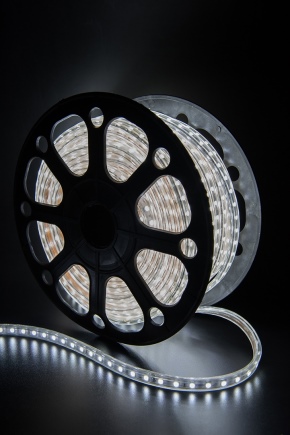
220 volt LED strip - fully serial, no LEDs connected in parallel. LED strip is used in hard-to-reach and protected from outside interference places, where any accidental contact with it during work is excluded.
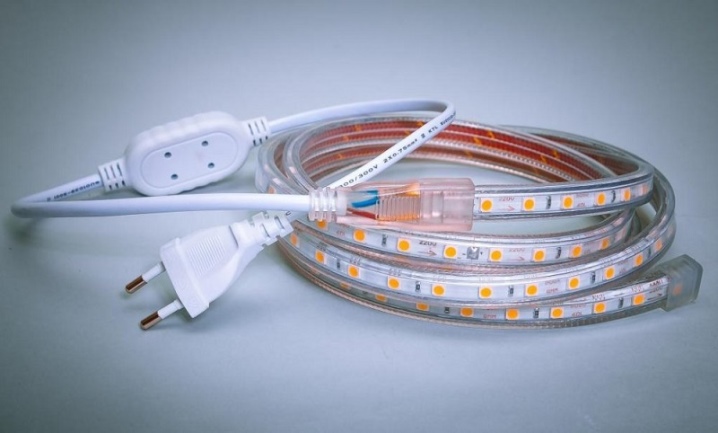
Peculiarities
The 220V assembly does not need a power supply. The simplest device only rectifies alternating current without converting it from 220 volts to 12 or 24 volts. In the simplest case, to illuminate the house from the outside, the tape is connected to the household lighting network through a special photo relay that monitors the illumination - turning on the current at dusk, and turning off the current at dawn. To turn off the tape before leaving, the owner can completely de-energize the entire assembly using switches connected in series.
Compared to full-fledged power adapters or drivers, a cord with a rectifier is several times cheaper - it uses the simplest elements.
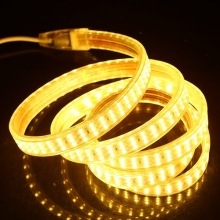
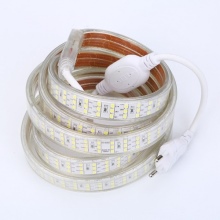
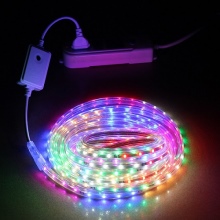
Assemblies of 1 m are connected in parallel. The length of the tape can be at least a hundred meters. The higher the voltage, the more efficiently it is transmitted over considerable distances - the current strength decreases by about the same amount as the potential itself increases (in volts). Therefore, the cross-section of the wires is not so important here. To illuminate longer sections, connectors are used, with the help of which the next tape (from the reel) is connected to the previous one. The disadvantage is a sharp power limitation: not all LEDs, being high-voltage, are able to withstand hundreds of watts of power, otherwise they would heat up no worse than a soldering iron.
It is recommended to solder the 220 V assembly. Soldering is the best contact: unlike connectors, it does not oxidize, since the solder is resistant to corrosion, and the bulk, the thickness of its drop at the point of attachment gives the solder additional strength. The 220 V light strip has a silicone coating that protects current-carrying and light-emitting elements from fog and precipitation.
After contamination, the coating can be wiped off.
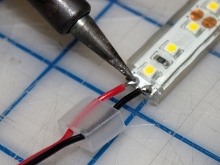
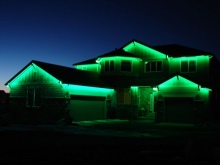
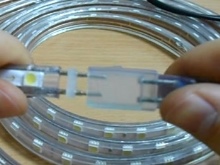
Without a power supply, the 220-volt light strip is sensitive to voltage surges. If suddenly an interphase (380 V) voltage is supplied to the network, or in your phase it rises to any value in the range of 220-380 volts due to the connection of devices and devices that are resistant to such drops, then the tape will overheat. In the worst case, it burns out immediately. When the voltage drops to 127 volts, it will not shine at all.
The 220 volt tape is not cut into several LEDs. The cut-off points are 60 LEDs apart. The length of such a cluster is at least one meter.
Cutting in arbitrary places will lead to the need for rework to a different voltage.
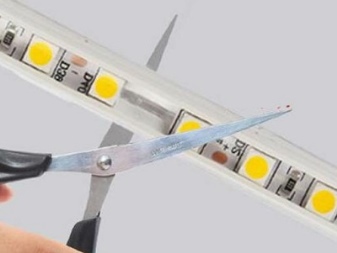
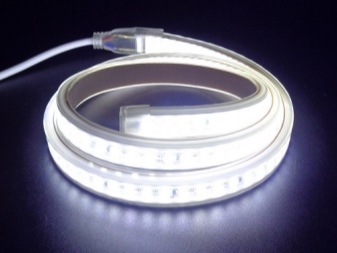
Without a rectifier, the tape flickers at a frequency of 50 hertz. For passers-by who are not affected by flicker, it is relatively safe - they do not look at it for a long time. At home or at work, where such a light flickers for many hours for a person, it leads to increased fatigue and headaches. To suppress the flickering of the light strip in rooms, it is equipped with a diode bridge, in parallel to which a ripple-smoothing capacitor is connected.
Cheap light tapes have a strong odor - the safe manufacturing technology of silicone has been violated. High-power light strips require an aluminum substrate to cool the LEDs during operation.High power requires a forced lowering of the supply voltage to 180 volts (60 LEDs of 3 V), otherwise, due to overheating (silicone does not conduct heat well) due to heat accumulation, the entire assembly will quickly degrade.
In the heat of summer and hot nights, the light gathering can come to an end - there is nowhere to remove excess heat.
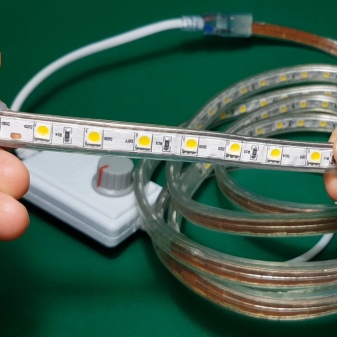
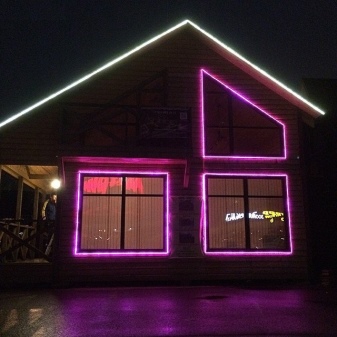
Overvoltage handling will require practical safety practices. It is impossible to work with the included tape without insulating gloves and with uninsulated tools. When working under stress, they show accuracy, utmost care. The assembly is carried out only when the power is off - when the wizard is working without additional means of protection. There is no self-adhesive backing - you need double-sided tape or regular all-purpose adhesive.
To make the tape work longer, for the sake of durability, the supply voltage is lowered to at least 180 V. In this case, the brightness can decrease by two to three times. Fastening to a cable reinforced with steel cable or wire (for example, computer twisted-pair cable for a LAN) will require plastic ties or stainless-coated wire.

Comparison with 12 and 24 volt tapes
The main difference is the inability to connect short clusters in parallel. Due to the lack of a power supply unit, the supply voltage can be adjusted only with the help of an adjustable network stabilizer. It is not always advisable to purchase such a device because of a single tape: even when it is possible to extend its service life by several years, it is unlikely that such a device will pay off in the near future. The stabilizer makes sense only in cases where the illuminated area is huge (square kilometer or more), and hundreds of such tapes (or conventional "cartridge" assemblies) are used to illuminate it.

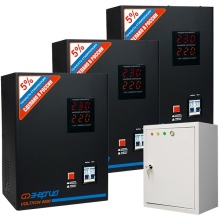
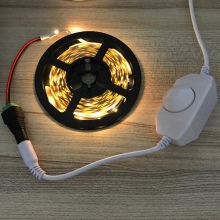
If 12 and 24 volt tapes are relatively easy to repair (only short clusters 3-10 LEDs long fail), then in a tape designed for mains voltage, you have to change the entire meter in a long assembly. Shortened light strips (half a meter, 30 LEDs) use series-pair diodes, each of which is designed not for 3, but for 6 V. The double crystal of such a diode saves on copper for conductive paths, an aluminum strip for heat dissipation and a dielectric (polymer) base that makes up the main material of the strip "nanoplate".
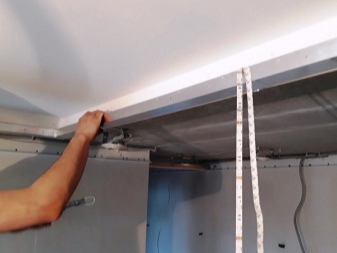

One cluster for 12-24 volts is only a few centimeters long. Cutting points closer to each other make it possible to replace any short section of the light strip. There is no need to cut a 220-volt tape - the electrical insulation of the assembly will deteriorate if no additional measures are taken. Unlike 5m coils with 12 and 24 volt supply voltages, the 220 volt reel is produced for 10-100 m.
It is indispensable in outdoor conditions - long wires with a thick cross-section cannot be stretched along the entire post, and the power supply cannot be hidden everywhere.
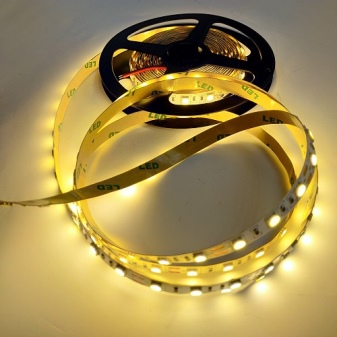
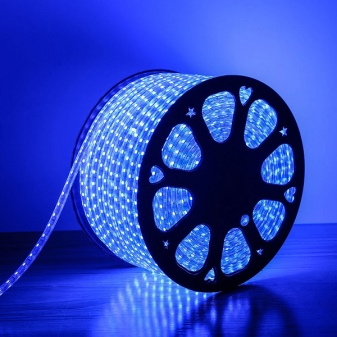
Views
According to the types of light tapes, there are different values of their parameters. And the main parameters, in addition to voltage, include the following.
- Specific power. The number of watts per linear meter is indicated.
- Luminosity. Indicated in suites or lumens - for the same meter.
- Moisture protection. The IP value is indicated - from 20 to 68.
- Execution. Open and closed - with a protective sheath.
A specific model contains only its inherent set of characteristics that have taken certain values.

By power
The powerful LED strip exceeds the consumption of 10 watts per meter. It will require a radiator - an aluminum substrate on which LEDs are glued with a flexible printed circuit board with the help of thermal paste or heat-conducting glue, on which they are located. With a significant excess of voltage in the supply network (up to 242 V), the light tape heats up noticeably.
If you do not take care of removing this heat, then the LEDs accumulate it little by little - faster than they have time to give it away. When the LED heats up to 60 degrees, it will soon fail. To avoid this, heat-dissipating strips have been invented. It is not required to increase the power of the light tape infinitely - after 20 W a full-fledged heat sink would be required. In this case, instead of tapes, spotlights are used - based on more powerful LEDs than the SMD-3 *** / 5 *** brand used in the tape.
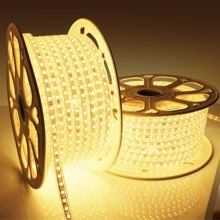
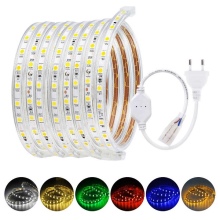

By moisture resistance
Not truly moisture resistant, sealed, light strips are generally labeled as IP-20/33. They are used only for rooms where there is no high humidity, equal to no more than 40-70%. With a high level of humidity - and such happens on the street always when the weather is damp and cloudy - light tapes with moisture protection IP-65/66/67/68 are used.
100% waterproofed tapes use a silicone layer as a coating - up to several millimeters. Silicone can be either ribbed or matte, or smooth and completely transparent, through which LEDs and conductive paths are visible.
Silicone, in which the production technology was violated and saved on basic materials, has a slightly lower light transmittance.
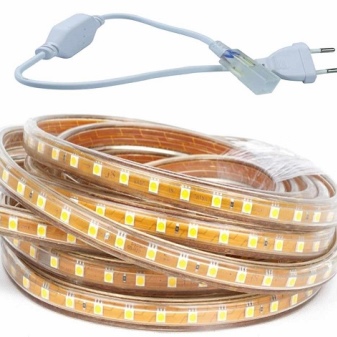

The convex coating has the effect of an elongated (oblong) lens that collects light flux within a certain area of the illuminated area, which also has an elongated shape. This is necessary so that extra light does not go to the road, but shines, for example, especially on the sidewalk near the store. Light fibers with a diffuser make it possible to distribute the light, creating a pattern or drawing of a certain shape on the illuminated area. They are used by some shops and companies that order a repeating logo on the tape that is clearly visible, for example, on the marble cladding of the sidewalk.
The higher the degree of waterproofing of the LED strip, the more it is suitable for use in situations close to extreme. If IP-20 tapes are suitable only as a product "behind glass", where moisture is practically excluded, then IP-68 tape can be immersed in a pool or aquarium for a long time.
Immersion is good for the products - cold water acts as a heat sink, removing heat from the entire surface of the product.
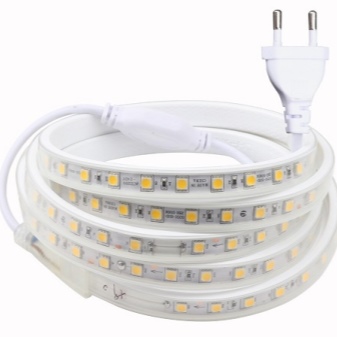
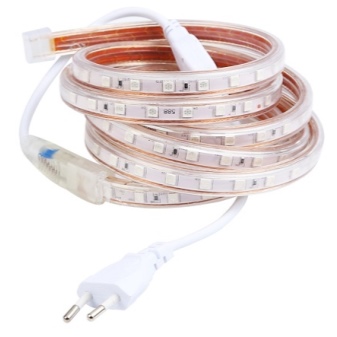
The only interfering factor here is the poor thermal conductivity of fiberglass and silicone. Heat that reaches the surface of the tape coating is immediately taken away by the water surrounding it. The waterproofed light tape partly replaces heating the aquarium or pool to a temperature that is comfortable for water procedures. This does not mean that overheating of the tape is abused - no matter how conductive the external environment is, LEDs degrade at excessive temperature and fail faster.
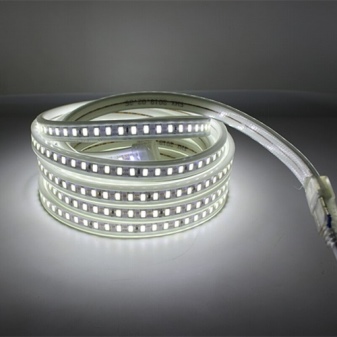
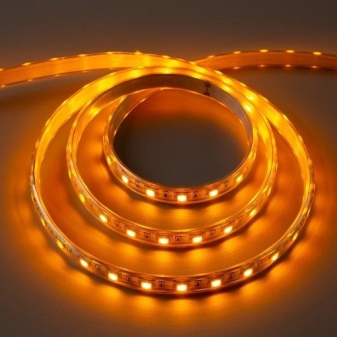
By color temperature
The color temperature of LEDs is measured in Kelvin. Shades 1500… 6000 K refer to a wide range - from reddish-orange to full-fledged white (daylight) light. The range of 7000 ... 100000 K acquires cyanotic hues, up to a significant shift towards the blue end of the spectrum (up to bright blue). Warm colors, up to white-yellow (the color of sunlight), are favorable for vision.
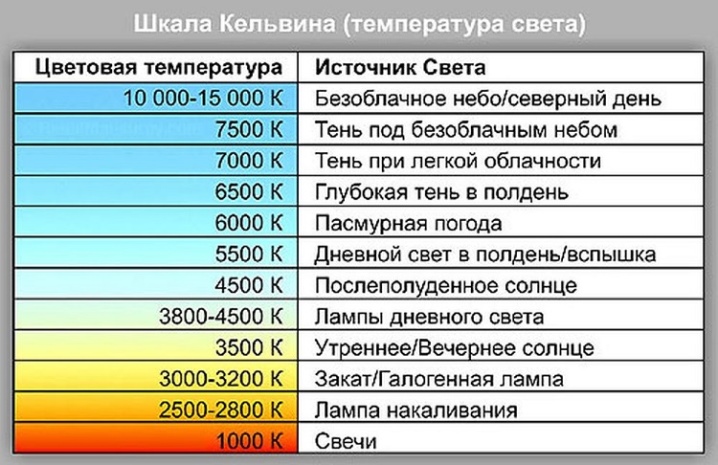
Eyes get tired faster from bluish-blue shades. Since a white LED glows with thermal radiation from a black body, green and other colors are absent in such colors. Green LEDs are already a modified technology, with the help of which this color can be obtained. Red, yellow, green and blue LEDs do not have such a parameter as color temperature - they are predominantly monochrome light-emitting crystals.
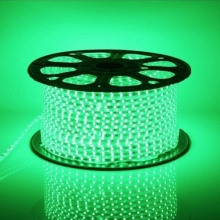

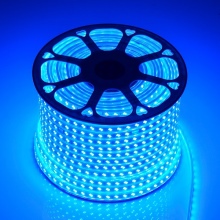
How to connect?
The diagram for connecting to a 220-volt LED network is as follows.
- In reality, a sequential set of 3 V LEDs is used.In the simplest case, 60 pieces connected in series and having a maximum operating voltage of 3.3 volts, in total, balance the voltage approximately equal to 220 V. Since the lower limit of white LEDs is 2.7 V , it is more correct to turn them on with the expectation of 3 V.This is equal to 74 LEDs, not 60. Manufacturers deliberately turn them on to work almost in peak mode - so that the tapes often burn out and be replaced with new ones. As a result, the tape or light bulb does not work 50-100 thousand hours, as indicated in the advertisement, but 20-30 times less. For colored LEDs, a different calculation is used - they are rated for 2, not 3 V.
- Next, a 400 V high-voltage capacitor is connected in parallel to the assembly.
- The output from the network diode bridge, which converts alternating current into direct current, is also connected here.
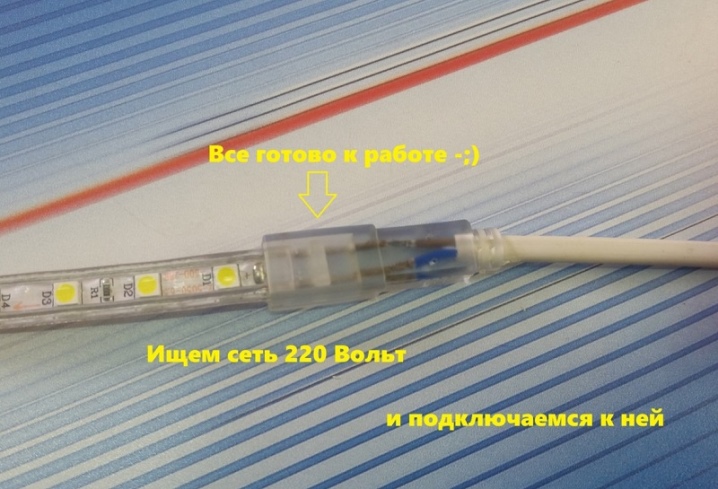
You can plug the LED chain directly into the network without using a rectifier and filter in the following cases.
- When the assembly is assembled with a margin. It is better to connect in series not 60, but 81 LEDs, since the voltage in the network deviates up to an extra 10% (242 V) due to the proximity to the transformer box and the shortened wiring. They will shine below average, but with sudden voltage surges (within the same 198 ... 242 V) they will not burn out. "Overkill" is completely excluded.
- Lighting is mounted for the street, yard, platform, vestibule, staircase, etc.., and not for work / living quarters where people spend a significant part of the time. The blinking is overwhelming for the eyes after an hour of work.
- The circuit has an additional low-power automatic fuse.
If you follow the recommendations for a competent, adequate recalculation before installation, a purchased / homemade light tape will last for many years, even with daily work.
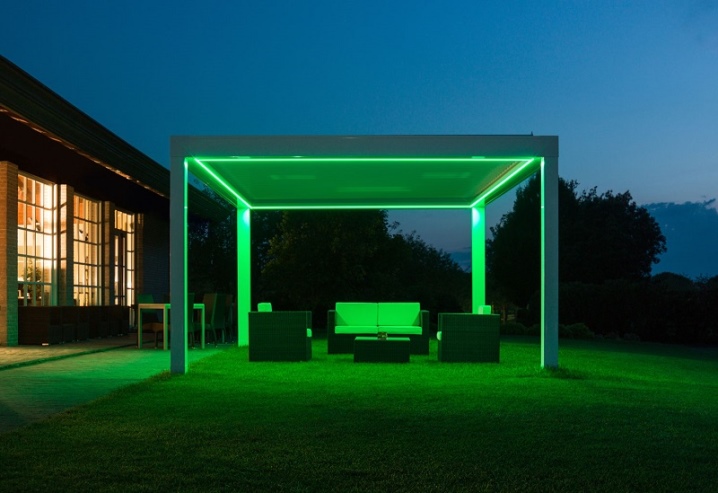













The comment was sent successfully.